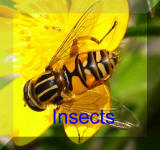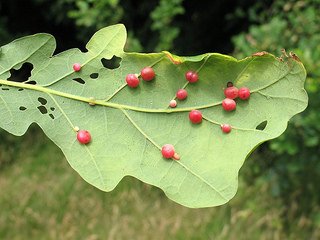Red-pea gall AKA Red Currant Gall Cynips divisa
Hymenoptera: Cynipidae
AKA Diplolepis divisa, Dryophanta divisa and Spathegaster verrucosus
Description
The red-pea gall or red currant gall develops as a chemically induced distortion arising from the underside of the mid-rib of a vein on Quercus species and it is attached by a short stalk or peduncle. The red-wart gall is the sexual phase of the same species
The Gall Appearance
It is glossy and somewhat flattened sphere and from ten to fifteen or so may occur on a single leaf. The average size is 5 by 6 millimetres and the colouring starts as green, passing to yellow, orange and then red-brown; the season is midsummer onwards. Circular emergence holes appear in the galls.
Life Cycle Many of the agamic imagines emerge in October. After overwintering, Cynips develops eggs parthenogenetically and their eggs develop in live buds as 'red-wart galls'. The infested buds become yellow, orange or a russet colour and are about 4 mm (0.16 in) long. These red-wart galls appear in May and the males and females of the bisexual genertation emerge in June and produce the fertilized eggs which undergo development in the red-pea galls
Habitat


